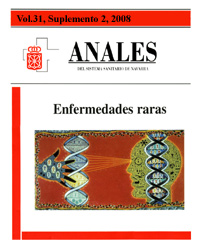Rare diseases. Concept, epidemiology and state of the question in Spain
Keywords:
Enfermedades Raras, Medicamentos huérfanos, EpidemiologíaAbstract
Rare diseases are those whose prevalence is below 5 cases per 10,000 inhabitants in the European Community. Most cases are diagnosed during paediatric age due to their genetic origin, while some others are congenital malformations. Nevertheless, a higher prevalence is seen during adulthood as most of the former diseases are very severe and patients die during childhood. At the same time, higher survival rates are related to some chronic rare diseases in adults. The Spanish Network of Research Epidemiology for Rare Diseases (REpIER) developed the first atlas showing the geographical distribution of rare diseases in Spain, assessed the Spanish rare disease registries, contributed to the further development of regional plans on rare diseases, as well as to social and health actions, and established the real group of needs to be solved. These have been included in the Communication of the European Commission on Rare Diseases as well as in the Spanish Senate Presentation.Downloads
Downloads
Published
How to Cite
Issue
Section
License
La revista Anales del Sistema Sanitario de Navarra es publicada por el Departamento de Salud del Gobierno de Navarra (España), quien conserva los derechos patrimoniales (copyright ) sobre el artículo publicado y favorece y permite la difusión del mismo bajo licencia Creative Commons Reconocimiento-CompartirIgual 4.0 Internacional (CC BY-SA 4.0). Esta licencia permite copiar, usar, difundir, transmitir y exponer públicamente el artículo, siempre que siempre que se cite la autoría y la publicación inicial en Anales del Sistema Sanitario de Navarra, y se distinga la existencia de esta licencia de uso.








